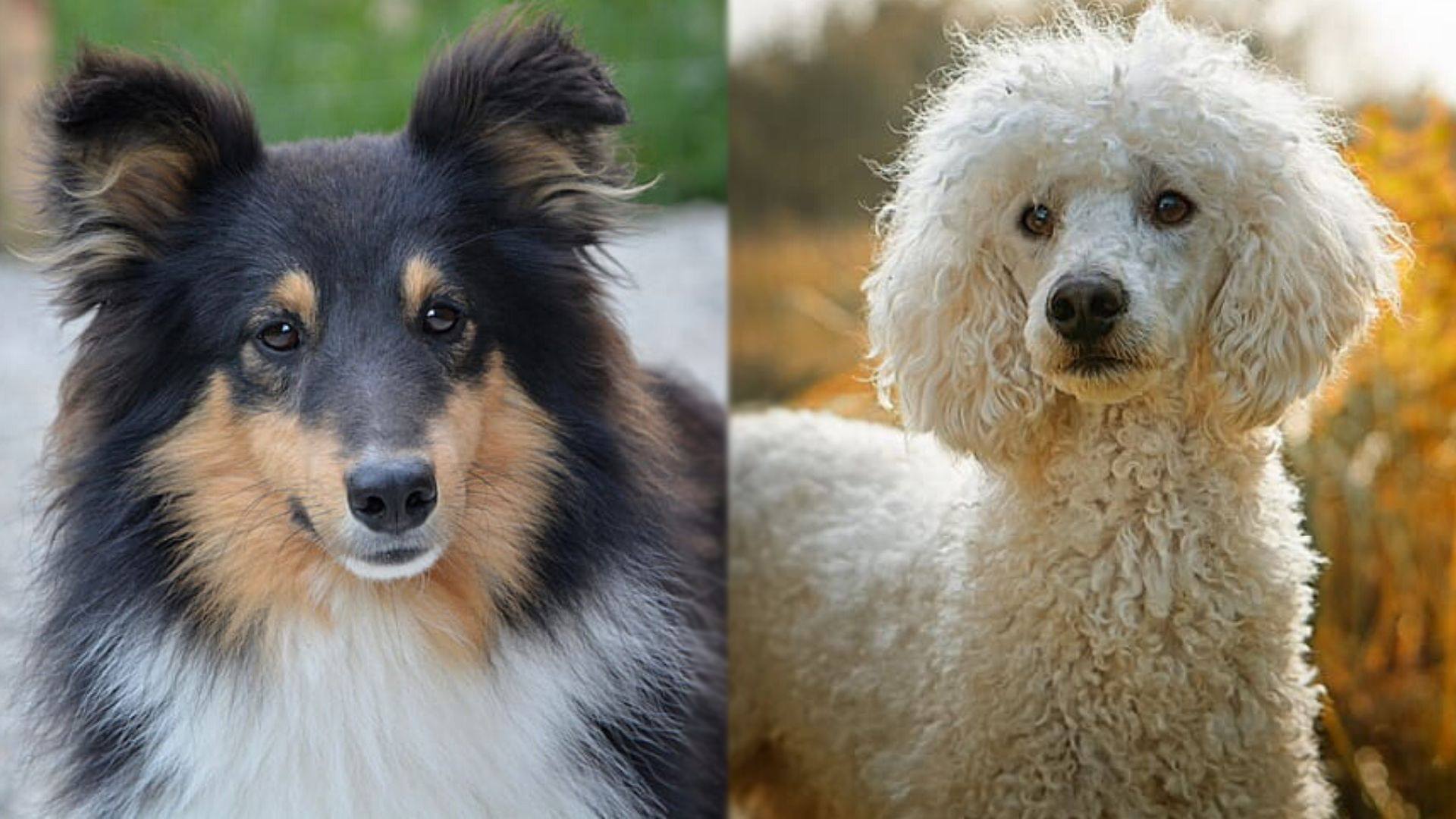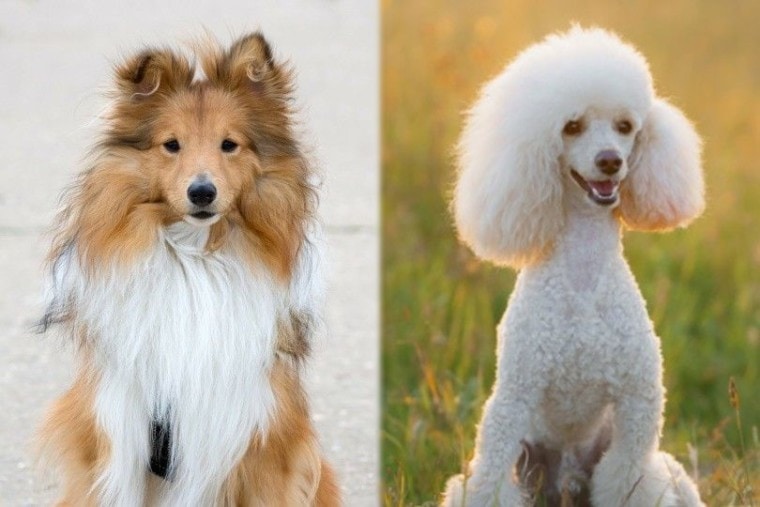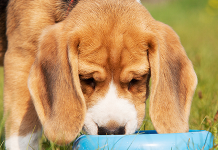Sheltidoodle: Sheltie Poodle Mix
| Height: | 14 – 19 inches |
| Weight: | 40 – 50 pounds |
| Lifespan: | 12 – 15 years |
| Colors: | Black, brown, cream, gray, white |
| Suitable for: | Families with large yards, families with kids |
| Temperament: | Loving, intelligent, highly trainable, energetic, playful |
A Sheltidoodle is a mixed breed dog that is a cross between a Shetland Sheepdog and a Poodle. These are fairly active dogs that are highly intelligent due to their Poodle parent and an active, outdoorsy dog due to their Shetland Sheepdog parent. One thing is for sure about these dogs: not only are they very sweet and affectionate, but absolutely beautiful as well due to the attractive coat and features of both of their parents.
- What Do Poodles Eat?
- How to Clean the Face of a Toy Poodle
- How Fast Can A Poodle Run?
- Can Poodles Eat Strawberries?
- Pudelpointer: German Water Poodle & British Pointer Mix
- Schipper-Poo: Poodle and Schipperke Mix
- Shmoodle: Mal-Shi & Toy Poodle Mix
- Chinese Crestepoo: Chinese Crested Poodle Mix
- Pooahoula: Catahoula Poodle Mix
- Eskapoo: American Eskimo & Poodle Mix
- Foodle: Poodle & Toy Fox Terrier Mix
- Foxhoodle: English Foxhound & Poodle Mix
If you’re considering owning one of these precious and lovable dogs, it’s important to learn everything that you possibly can about them. That way, you know what you’re getting into and there are no surprises. We don’t mean that in a bad way; we just want to make sure that you have everything you need to care for these dogs as well as the time as energy to do so. That’s why we’ve created this guide to teach you everything you need to know about owning a Sheltidoodle.

What is a Sheltidoodle?
- The Sheltidoodle is also known as the Sheltipoo, but regardless of what you call this pooch, one thing is certain: this hybrid breed is popular for many reasons, and once you meet one of these special canines, you’re sure to fall in love.
- Keep reading to learn more about the Sheltidoodle to determine if this particular dog breed is the one that you have been searching for.
- The Sheltidoodle is a cross between a purebred Shetland Sheepdog and Poodle.
Origin
The Sheltidoodle is a designer crossbreed from the United States.

Pedigree
The Sheltidoodle is a cross between a purebred Shetland Sheepdog and Poodle.
Diet and Nutrition
All dogs, not just purebreds, benefit from high-quality dog food, and this includes Sheltidoodles. The best type of dog food, in particular, is one that is high in protein and low in fat in order to help keep your dog’s muscles lean and healthy.
It’s also important not to overfeed your Sheltidoodle, as dogs are prone to obesity due to being overfed or allowed to eat whenever they want to. In general, a Sheltidoodle should eat between 2-3 cups of food per day divided into two meals. Keeping your dog on a feeding schedule can help ensure that they are not being overfed.

How easy are Sheltidoodle to train?
- Sheltidoodles are highly trainable dogs due to the intelligence that they get from their Poodle parent and the obedience that they get from their Shetland Sheepdog parent. Even as a puppy, you should have no problem with teaching your dog basic commands, especially through the use of positive reinforcement and treats to let them know that they are doing a good job.
- Once your Sheltidoodle has mastered the basic commands, you can also try to teach her more complex commands. This will not only keep her mind engaged and stimulated, but it will allow you to exercise your dog at the same time. Agility tricks and competitions can be a great way to show off how smart and fun your dog is as well.
Weight

A medium-sized breed, the Sheltidoodle weighs between 30 and 60 pounds.
How would you describe the temperament of Sheltidoodle?
- One of the benefits of mixed breed, designer dogs is that you can create any type of personality and temperament that you could possibly want in a dog. And when it comes to the personality and temperament of a Sheltidoodle, they truly have one of the best of any dog breed.
- As we previously touched on a little, Sheltidoodles have a high level of intelligence and obedience, which means that they are very easy to train. They are good at maintaining their focus and once trained, they know what their owner expects of them.
- That being said, they also know how to have fun and won’t hesitate to play or run around with you. They love being outside, so living in a small apartment without plenty of space to play is not an ideal living situation for these dogs. They benefit massively from daily walks and playtime, and they really don’t care what sort of activity they are participating in as long as they get to be outside.
- Another great characteristic of these dogs is that due to their herding background, they make great farm dogs. Sheltidoodles love to feel useful, and what better way to make them feel that way than by letting them hone their natural herding abilities. Even if you don’t have a farm, a big, fenced-in yard is a huge advantage when owning one of these dogs.
- Finally, Sheltidoodles are highly affectionate and very loving dogs. They are incredibly loyal to their families and want to protect them without being aggressive about it. They make great watchdogs without being too serious and aloof toward new people.
How healthy are Sheltidoodle?
Since Sheltidoodles are cross-bred dogs, they aren’t as likely to suffer from genetic conditions as purebred dogs are. However, it is possible that your dog could get whatever conditions the parents have. This is why it is so important to get any medical information about the parent dogs from the breeder upon initially getting your dog.
Some conditions that may affect your Sheltidoodle can affect all dog breeds, such as eye conditions and hip and elbow dysplasia. But there are other conditions such as sebaceous adenitis or bloat that can affect Poodles and other similar breeds. Conditions such as Von Willebrand’s disease and Collie eye anomaly are sometimes found in Shetland Sheepdogs.
That doesn’t necessarily mean that your dog will definitely have these conditions. But yearly veterinary checkups are important to catch and treat any potential medical issues before they become a problem.
How long will Sheltidoodle live?
The Sheltidoodle has an average lifespan of 12 to 15 years.
How active are Sheltidoodle?
Sheltidoodles aren’t the most active dog breed, but they do enjoy getting to run around and play. They need a moderate amount of exercise and stimulation per day as a result, usually around 60 minutes. That doesn’t mean that you have to play with them for that long. You can break that exercise up into increments as long as they get a total of 60 minutes of exercise per day.
You can take them for walks or just let them run around in the background to get their daily exercise in. Playing fetch or tug-of-war with your dog is another great way to provide them with exercise and giving her plenty of toys to play with indoors or out can help stimulate her mind so that she doesn’t get bored. Having a fenced-in yard is a good idea too. That way, if you have to leave your dog to go to work, he or she can still get some exercise in by running around outside.
Recognized Clubs
The Sheltidoodle is not recognized by the American Kennel Club, as it is considered to be a hybrid breed. However, this breed is recognized by the American Canine Hybrid Club (ACHC), the Designer Breed Registry (DBR), the Designer Dogs Kennel Club (DDKC), the Dog Registry of America, Inc. (DRA), and the International Designer Canine Registry (IDCR).
Coat
When it comes to the coat of your Sheltidoodle, there are two types you could end up with. If she gets the Poodle coat, it will be curlier and will require more frequent brushing in order to keep it from getting tangled and matted. You’ll also have to have it groomed more frequently in order to keep it looking its best, but you shouldn’t have to worry about shedding too much as Poodles are very low-shedding dogs.
If your Sheltidoodle gets a coat that is more similar to a Shetland Sheepdog, it will likely be wavier and thicker. You won’t need to brush it as often, maybe only twice a week. But your dog will shed more, especially during warmer months during which you may want to have your dog’s coat trimmed in order to reduce the amount of shedding that occurs.
Puppies
Sheltidoodle puppies are small and delicate, so they should be handled with care. Teach your kids to be gentle with these dogs as well. Then start training your puppy early so he will learn the rules of the house right away.
Once your pet is comfortable around his human family, he can also be socialized to get along with other people and other animals. Doing so will ensure your pooch will grow up to be happy and confident.
Related Questions
Does This Breed Get Along with Other Pets?
Sheltidoodles will get along with your other pets just as well as they will with your kids as long as they have plenty of time to warm up to and get to know your other pets. They don’t mind sharing the love. But of course, the best way to ensure that this happens is to socialize your Sheltidoodle from puppyhood. That way, your pup will be able to grow up around your other pets and the other pets will have plenty of time to adjust and get to know their new family member.
Are These Dogs Good for Families?
- Sheltidoodles are wonderful family dogs, especially if you have children. The more members of your family, the more people there are for your Sheltidoodle to love and play with. They especially love kids who have higher energy levels that they can spend their time playing with.
- But that doesn’t mean that you don’t have to supervise your Sheltidoodle around your kids. All dogs should be supervised around kids, but in the case of Sheltidoodles, they may try to “herd” your kids if you have more than one. They may resort to herding tactics in the process and could accidentally knock a small child off of his or her feet. As long as you teach both your kid and your dog how to interact with each other as well as keep a close watch on them, you shouldn’t have any problems.
Final Thoughts
If you want a highly intelligent and obedient but fun-loving dog, then a Sheltidoodle may be the perfect dog for you. But you need to be able to provide your dog with the care that it needs to thrive. This includes having time for grooming and playing with your dog as well as making sure that he or she receives vet care when needed.
If you can provide those things and you have a big yard and kids as a bonus, you really do have the perfect environment in which to invite one of these beautiful, loyal, and loving dogs into your family. But, even if it’s just you and your Sheltidoodle, the two of you are sure to enjoy a truly special companionship that will last for many years.






